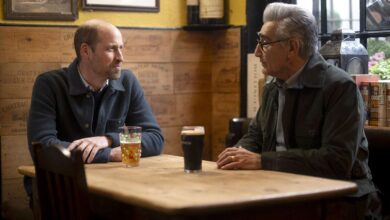‘House of Guinness’ Fact vs. Fiction
:max_bytes(150000):strip_icc():format(jpeg)/house-of-guinness-netflix-arthur-guinness-main-092525-84051d55f9ce4137a13e78c0cb9f8d86.jpg)
Netflix’s new historical drama House of Guinness brings the epic story of the legendary Guinness family — and the iconic brewery that bears its name — to the small screen.
The series, which takes place in 19th-century Ireland and New York, is set during a particularly precarious time in the family’s history. The eight-episode drama begins with the death of Sir Benjamin Lee Guinness — the grandson of Guinness Brewery founder Arthur Guinness — in 1868. His four surviving children – Arthur (Anthony Boyle), Edward (Louis Partridge), Anne (Emily Fairn) and Benjamin (Fionn O’Shea) – must not only grapple with the loss of their father, but also the pressure of maintaining the family’s immense success and future legacy.
Threatening that mission are the siblings’ own dark secrets, as well as political unrest, crooked business deals and extended family tension. But how much of what happens in House of Guinness is true?
The series, which comes from Peaky Blinders creator Steven Knight, claims to be fiction inspired by true stories. Knight took real members of the Guinness family and “remarkable” events in the family’s history and then used his own creative license to come up with the rest.
“There’s no Facebook, no Instagram pages,” he told Netflix’s Tudum about his research for the series. “What I had to do is take things that these family members did, things that they said, achievements they made, mistakes that they made, and use them as stepping stones. Then I had to fill in the gaps myself.”
Here’s everything to know about what is fact and what is fiction in the period drama.
Warning: House of Guinness spoilers ahead!
Did Sir Benjamin Lee Guinness leave the Guinness Brewery to his two sons, Arthur and Edward?
Ben Blackall/Netflix
Sir Benjamin Lee Guinness was the grandson of the first Arthur Guinness, who famously invented Guinness Beer, founded the Guinness Brewery and signed a 9,000-year lease on the St. James Gate Brewery in Dublin.
He joined his father (the second Arthur Guinness) in the family business as a teenager. Though he had two older brothers, Benjamin eventually took over the brewery from his father in 1839 and ran it solo until his death in May 1868.
Just as depicted in the Netflix series, Benjamin had four children — Anne, Arthur, Benjamin and Edward — and in his will, Benjamin handed joint control of the Guinness Brewery over to two of his sons, Arthur and Edward.
However, in House of Guinness, Benjamin’s will declared that if either Arthur or Edward declined to run the brewery, they forfeited their inheritance, which was not the case in real life.
According to the Illustrated London News, Benjamin’s will stated that “should either [Arthur or Edward] decline, his share is to revert to the other on his paying to him in satisfaction £30,000 and half the value of the stock” — meaning the brothers had the option to buy each other out of the business.
Did Arthur Guinness lose his Parliament seat because of election fraud?
Ben Blackall/Netflix
Arthur Guinness was elected as a Conservative Member of Parliament for the city of Dublin in 1868.
However, the election was later voided after it was discovered that “corrupt practices” had taken place — namely, men were bribed to vote for Arthur. The court later determined that Arthur was unaware of these bribes, which allowed him to escape punishment and run again in 1874.
Was Edward Guinness responsible for bringing Guinness beer into America?
Ben Blackall/Netflix
In House of Guinness, Edward is depicted as having the idea to expand Guinness into the United States for the first time — and doing so with the help of his illegitimate cousin, Byron Hedges (Jack Gleeson).
But Hedges appears to be a fictional character, and Guinness actually made its way to the U.S. several decades earlier, in 1817. According to a handwritten brewer’s log, the first barrels of Guinness beer arrived in South Carolina (not New York, as shown in the series) on Oct. 16, 1817 — more than 50 years before Edward was running the brewery.
Was the Irish Republican Brotherhood a real movement in Ireland?
Ben Blackall/Netflix
The political tensions shown in the Netflix series were very much a reality in 19th-century Ireland. The Irish Republican Brotherhood — also known as Fenians — was a secret political organization that sought to establish an independent Irish Republic outside of British rule. The movement looked to achieve independence through an armed revolution.
House of Guinness also references raids conducted by the Brotherhood in New York on the Canadian border. There were several attempted invasions of Canada by the American members, including one that occurred in May 1870 (which aligns with the timing of the show), where they tried to invade Quebec through the border in upstate New York, but were unsuccessful.
Were Patrick and Ellen Cochrane leaders in the Irish Republican Brotherhood?
Ben Blackall/Netflix
In House of Guinness, Patrick Cochrane (Seamus O’Hara) is depicted as a Fenian leader, while his sister, Ellen Cochrane (Niamh McCormack), is the head of the Ladies’ Committee within the movement.
However, both Patrick and Ellen appear to be fictional characters — though they have some roots in history.
There was a brother-sister duo within the Irish Republican Brotherhood and the Ladies’ Committee in the 19th century: John O’Leary was a Fenian leader and the editor of the movement’s newspaper, The Irish People, according to The New York Times.
His sister, Ellen O’Leary, was one of the founding members of the Ladies’ Committee, per The Irish Times.
Did Anne Lee Guinness suffer from a mysterious illness?
Ben Blackall/Netflix
Anne, the only daughter of Sir Benjamin Lee Guinness, is shown in the Netflix series as dealing with an unknown illness that leaves her weak on her left side and gets progressively worse as time goes on.
Doctors are unable to determine what is wrong with Anne, and by the season finale, she is seen needing the assistance of a cane to walk. In real life, Anne was reported to have suffered from a degenerative illness for most of her life. She died in 1889 at the age of 50.
Did the Guinness family build affordable housing projects within Dublin?
Ben Blackall/Netflix
In House of Guinness, an affordable housing project known as the Guinness Housing Trust was completed in 1870. The endeavor — which involved bulldozing local slums and replacing them with apartments for poor families — is the brainchild of Anne Guinness and Lady Adelaide Guinness (Ann Skelly), the siblings’ first cousin and Edward’s future wife.
But according to the Guinness Partnership, it was Edward who established the Guinness Trust, setting aside £250,000 (equivalent to £25 million today) so that “ordinary people” in London and Dublin could have access to quality housing.
Was Arthur Guinness’ life threatened when he ran for Parliament the second time?
Ben Blackall/Netflix
In the final episode of House of Guinness, Arthur is grappling with the threat of an assassination plot during his second campaign for Parliament. Those seeking to take him out are the Fenians, led by a vengeful Patrick — but whether or not he is successful in his mission to kill is unknown at the end of the intense finale.
In real life, Arthur did receive a death threat, but it came in 1872 — two years prior to his second Parliament campaign — when he sponsored an exhibition in Dublin to promote Irish trade.
After Arthur corrected an error about the exhibition published in the Freeman’s Journal, a letter was published in The Times that issued Arthur the following threat: “For we will send you a bullet … as we have a person hired to shoot you … so take warnin in time.”
Credit to Nypost AND Peoples



